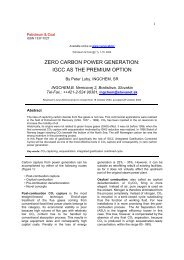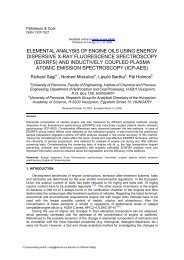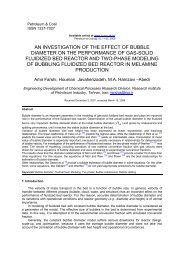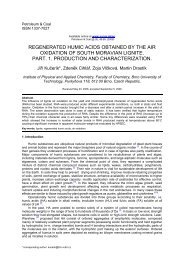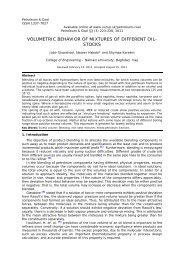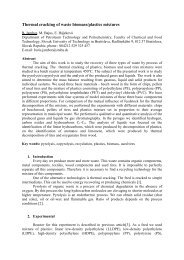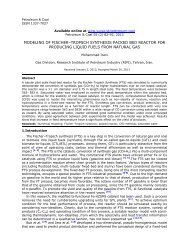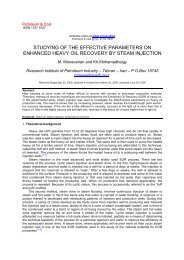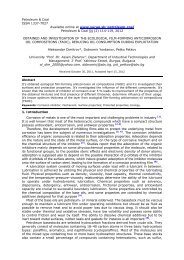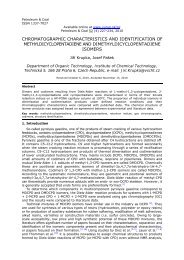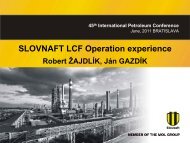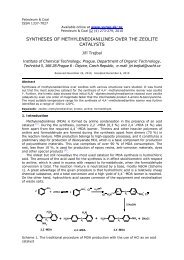THE INFLUENCE OF MECHANICAL EFFECTS ON DEGRADATION ...
THE INFLUENCE OF MECHANICAL EFFECTS ON DEGRADATION ...
THE INFLUENCE OF MECHANICAL EFFECTS ON DEGRADATION ...
Create successful ePaper yourself
Turn your PDF publications into a flip-book with our unique Google optimized e-Paper software.
Petroleum & Coal<br />
ISSN 1337-7027<br />
Available online at www.vurup.sk/petroleum-coal<br />
Petroleum & Coal 53 (3) 218-222, 2011<br />
<strong>THE</strong> <strong>INFLUENCE</strong> <strong>OF</strong> <strong>MECHANICAL</strong> <strong>EFFECTS</strong> <strong>ON</strong> DEGRADATI<strong>ON</strong><br />
<strong>OF</strong> POLYISOBUTYLENES AS DRAG REDUCING AGENTS<br />
Jabir Shanshool 1 , Marwa F. Abdul Jabbar 1 and Izzat N. Slaiman 2<br />
1 Chemical Engineering Department, College of Engineering, Nahrian University, Baghdad,<br />
Iraq, 2 Petroleum Engineering Department, Kirkuk University, Iraq<br />
Received February 9, 2011, Accepted August 15, 2011<br />
Abstract<br />
The mechanical degradation of high molecular weight polyisobutylene polymers (Oppanol B) was<br />
studied by exposing there dilute solutions to high speed mechanical stirring. Three Oppanol B,<br />
150, 200 and 250 types of molecular weight, 2.5, 4.1 and 5.9million g/mole were considered in<br />
present work. The shear viscosity of Oppanol B stock solutions of concentrations, 0.5, 1.0 and<br />
1.4w/v% was measured as function of exposure time.<br />
It was observed, that the degradation efficiency of higher molecular weight is larger than that of<br />
lower molecular weight in a whole polymer concentrations. The time dependence drag− reduction<br />
data was compared with the observation of shear degradation by stirring behavior. The decrease<br />
of drag reduction with time is in evident to the mechanical degradation observed by shear stirring<br />
and viscosity decline of polymeric additives.<br />
Keywords: Turbulent drag reduction; High molecular weight Polyisobutylene; Mechanical Degradation; Viscosity<br />
lowering.<br />
1. Introduction<br />
It is well known that the addition of small amount of certain polymer types to a turbulent<br />
Newtonian fluid flow can result in a drag reduction [1] . Effective polymeric drag reducing<br />
additives are considered to be flexible, linear with a high molecular weight such as polyisobutylene<br />
(PIB) [2] . However, the usage of these polymers is limited because of their<br />
susceptibility to flow induced shear degradation [3] . High molecular weight polymers are<br />
more susceptible to shear induced degradation, and polymers with linear chain structure are<br />
more vulnerable than branched polymers.<br />
The degradation of polymers by mechanical action is a depolymerization reaction in<br />
which the activation energy is supplied by the mechanical action on the polymer. Degradation<br />
reduces the effectiveness of polymer additives because of the strong dependence of<br />
effectiveness on molecular weight [4] . Since the long chain polymer having different molecular<br />
weights will show different time dependent resistance. In other words, longer molecules<br />
are more susceptible to mechanical degradation, accompanying more rapid degradation [5] .<br />
Mechanical degradation refers to the chemical process in which the activation energy<br />
of polymer chain scission is exceeded by the mechanical action on the polymer chain and<br />
bond rupture occurs [6-7,8-14] . Degradation of polymers may be brought about either by<br />
physical factors, such as heat, light or mechanical stress or by chemical agents, such as<br />
oxygen, ozone, acids or alkalis [15] . The degradation can be prevented by avoiding high<br />
speeds in stirring or transporting polymers solutions; using the low temperature as possible<br />
commensurate with prevention of thermal degradation and using good solvents (those<br />
with high intrinsic viscosity) of low viscosity [16] .<br />
The present work deals with the experimental data for mechanical degradation and the<br />
performance of drag reducing polymers. Dilute solutions of polyisobutylene with high, different<br />
molecular weights were exposed to shear degradation using mechanical stirrer with blades.<br />
The time dependence effectiveness of polyisobutylenes as drag-reducer agents was also<br />
studied in a closed re-circulation loop to evaluate there mechanical degradation ability.<br />
2. Experimental<br />
The hydrocarbon soluble polyisobutylenes, grade Oppanol 150, 200 and 250 with<br />
different molecular weight of 2.5*10 6 , 4.1*10 6 and 5.9*10 6 g/mole respectively, were
acquired from BASF Company, Germany. Kerosene solvent to dissolve the<br />
polyisobutylenes was supplied from AL–Durra Refinery, Baghdad.<br />
The dissolving of high molecular weight polyisobutylene polymers were carried out in a<br />
shaking machine of 100rpm at room temperature. This condition was used to avoid any<br />
polymer molecular degradation since the stirring device has no blade or sharp edge that<br />
could expose the polymer to high shear forces.<br />
The polymeric solutions of different concentrations were exposed to high speed stirring<br />
at different time. The viscosity of the solutions was measured as function of time and<br />
stirring speed, to evaluate the degree of polymeric degradation. The stirrer used has a sharp<br />
edge and rotating speed. Solutions of concentrations, 0.5, 1.0 and 1.4w/v percent for polyisobutylene<br />
were exposed to such shear degradation at 1200, 1500 and 1800 rpm stirring<br />
for different time up to 2hr. Samples were taken to measure the viscosity of the solution.<br />
All experiments were taken place at room temperature, 30–35 о C. The viscosity was measured<br />
by using Brookfield DV–E viscometer, which measures fluid viscosity at a different shear<br />
rates and shearing time.<br />
The performance of the drag reducing additives was evaluated in a laboratory scale<br />
circulation loop, as shown in figure1. The fluid container of about 0.49m 3 capacity was<br />
fitted with a positive displacement gear pump of 50.8mm diameter and 1440rpm. This type<br />
of pump was used to avoid polymer mechanical degradation which reduces usually the drag<br />
reducing efficiency. Pipe of 0.0317m inside diameter was used to perform the flow measurement<br />
. The test section was 2m long and located away from the entrance to get the<br />
fully developed region. The pressure drop in the test section was measured by U-tube<br />
manometer filled with water. The pressure drop readings before and after drag reducer<br />
addition were used to calculate the percentage drag reduction, %DR, as follows.<br />
ΔPuntreated<br />
− ΔPtreated<br />
% DR =<br />
* 100<br />
Δ P<br />
untreated<br />
J. Shanshool et al./Petroleum & Coal 53(3) 218-222, 2011 219<br />
Fig. 1 Schematic diagram for circulation loop<br />
3. Results and discussion<br />
The viscosity changes of high molecular weights polyisobutylens polymers Oppanol B<br />
dissolved in Kerosene were investigated by exposing the dilute solutions to high mechanical<br />
stirring, 1200, 1500 and 1800rpm.Three Oppanol B, 150, 200 and 250 types of molecular<br />
weight 2.5, 4.1 and 5.9million g/mole were considered in present work.<br />
Table 1 summarizes selected results to clarify the effect of stirring speed on viscosity<br />
lowering of 1.4wt% solutions of the three types of Oppanol polymers at 2hr exposure time.<br />
The results indicate clearly the effect of high level of shearing on viscosity reduction due<br />
to mechanical shear degradation on polymer molecules. Shearing at higher stirring speed<br />
(i.e 1800rpm) resulted on high viscosity reduction of polymeric solutions. It is well expected
that the viscosity of Oppanol B solutions increase as molecular weight of polymer increase,<br />
as shown in table 1 and figure 2. Furthermore, the viscosity of polymeric solution is usually a<br />
function of concentration as shown in figure 2. As in case of Oppanol 250, the viscosity of<br />
0.5, 1.0 and 1.4w/v% solutions are about 63cp, 293cp and 623 respectively.<br />
Table 1: Effect of stirring speed on viscosity of Oppanol solutions at 1.4%, 2hr stirring time<br />
rpm<br />
-<br />
1200<br />
1500<br />
1800<br />
B 150<br />
120<br />
103<br />
89<br />
82<br />
J. Shanshool et al./Petroleum & Coal 53(3) 218-222, 2011 220<br />
B 200<br />
232<br />
160<br />
134<br />
101<br />
B 250<br />
623<br />
368<br />
317<br />
205<br />
The decrease of polymer solution viscosity with increasing time of shearing is shown in<br />
figure 3. The experiments were carried out on 1.4%wt polymeric concentration and 1800rpm<br />
stirring . It can be concluded from this figure that a gradual lowering of viscosity is observed<br />
with increasing the exposure time due to mechanical degradation. At 60min stirring the<br />
viscosity changed dramatically from 120, 232 and 623cp to around 97, 132and 339cp for<br />
Oppanol B 150, 200 and 250 respectively. Therefore, the highest molecular weight polymer<br />
undergoes faster degradation leading to higher lowering in viscosity than the lower molecular<br />
weight polymers such as B 150.<br />
700<br />
600<br />
oppanol 150<br />
oppanol 200<br />
oppanol 250<br />
700<br />
600<br />
oppanol 150<br />
oppanol 200<br />
oppanol 250<br />
500<br />
500<br />
Viscosity (cp)<br />
400<br />
300<br />
200<br />
viscosity (cp)<br />
400<br />
300<br />
200<br />
100<br />
100<br />
0<br />
0 30 60 90 120 150<br />
Time (min)<br />
0<br />
0.20% 0.70% 1.20% 1.70%<br />
C % w/v<br />
Fig. 2 Combined effect of concentrations<br />
and molecular weight on the viscosity of<br />
Oppanol B solutions<br />
700<br />
600<br />
Fig. 3 Viscosity variation of Oppanol B<br />
polymers by exposing 1.4 w/v % solutions<br />
to mechanical stirring at 1800rpm<br />
0.5%<br />
1.0%<br />
1.4%<br />
viscosity (cp)<br />
500<br />
400<br />
300<br />
200<br />
100<br />
0<br />
0 30 60 90 120 150<br />
Time (min)<br />
Fig. 4 Concentration effect on viscosity for Oppanol B-250 solution at 1800 rpm
J. Shanshool et al./Petroleum & Coal 53(3) 218-222, 2011 221<br />
The effect of concentration of polymer solutions on the scission of polymer chains by<br />
high speed stirring had been investigated by change the viscosities, as shown in figures 4<br />
for Oppanol B 250. Three polymer concentrations were chosen, namely 0.5%, 1.0%<br />
and 1.4%w/v to evaluate the concentration dependence of shear degradation of the<br />
three Oppanol polymers by expose there solutions to high speed stirring. It was found<br />
that the low concentration solutions are less sensitive to shear degradation by<br />
mechanical stirring. The polymer chain scission is largely dependent on the<br />
concentration of polymer solution that lead to the conclusion that the polymer chains<br />
were not broken by contact only with solvent but even though by contact of a polymer<br />
chain (entanglement) with other chains [9] .<br />
As illustrated adequately in the previous paragraph, the viscosity of Oppanol B polymers<br />
undergo remarkable reduction by exposure there solutions to high speed mechanical stirring.<br />
Therefore it was worthy to compare the results of shear degradation by stirring of the<br />
three Oppanol polymers solution with the values of time dependence drag–reduction<br />
efficiency. Since the long chain polymers experience mid–point degradation, leading to<br />
the fact that the molecular chains having different molecular weights will show different<br />
time dependent resistance. The time dependence drag–reduction results for these polymers<br />
are shown in figure 5 which were carried at 6.0m 3 /hr flow rate in 31.75mm I.D pipe. The<br />
figure indicates that, the low molecular weight polymers are sharply degraded within the<br />
first hour resulting in fast decrease of percentage drag–reduction. While the higher<br />
molecular weight polymer has higher resistance towards the degradation. Therefore in case<br />
of Oppanol B 250 additive, still about 9% drag reduction was achieved after 210min operation<br />
due to presence of efficient molecules, which act as drag reducer agents. The effectiveness<br />
of low molecular weight polymer B 150 was completely vanished after about one<br />
hour circulation leading to minor drag reduction , while B 200 shows little drag–reduction<br />
effectiveness after 150min circulation. It was observed previously that exposure of<br />
Oppanol B, 150, 200 and 250 polymeric solutions to high speed stirring, (1800rpm)<br />
leading to noticeable decrease in viscosity due to mechanical degradation.<br />
The time-dependence drag reduction of Oppanol B 250 at different concentrations is<br />
plotted in figure 6 taking the time zero for maximum drag reduction. This figure indicates<br />
clearly that low concentrations will be degraded quickly compared with high concentration<br />
i.e 50ppm. Therefore the percentage DR decrease rapidly reaching to zero value after<br />
60min for 10ppm and 120min running for 30ppm. While at 50ppm concentration there is<br />
still undegraded polymer until 220 min experimental time elapsed. Since degradation is<br />
generally attributed to mechanical breaking of the polymer chains and when a low concentration<br />
exists in the pipe a larger performance of chains are destroyed and consequently a<br />
rapid decrease in the effective drag reduction is noticed. While, for high concentrations<br />
i.e 50ppm there is still sufficient effective polymer left to cause drag reduction at the<br />
considered experimental time.<br />
24<br />
20<br />
Oppanol B 150<br />
Oppanol B 200<br />
Oppanol B 250<br />
24<br />
20<br />
10 ppm<br />
30 ppm<br />
50 ppm<br />
16<br />
16<br />
DR%<br />
12<br />
8<br />
DR%<br />
12<br />
8<br />
4<br />
4<br />
0<br />
0 30 60 90 120 150 180 210 240<br />
Time (min)<br />
Fig. 5 Effect of molecular weight on degradation<br />
of Oppanol B additives, at Q= 6<br />
m 3 /hr, 50 ppm concentration and 31.75<br />
mm I.D<br />
0<br />
0 30 60 90 120 150 180 210 240<br />
Time (min)<br />
Fig. 6Time dependence of percentage<br />
drag-reduction for Oppanol B 250 at<br />
different concentration, 6 m 3 /hr flow rate<br />
and 31.75 mm I.D
As already reported previously the largest lowering in the solution viscosity of Oppanol<br />
polymers due to mechanical degradation occur with polymeric solution of highest concentration,<br />
as shown in figure 4 for type B 250 polymer. Thus, the viscosity of Oppanol B<br />
250, decreases from 63cp before mechanical stirring to about 29cp, 293cp to 116cp and<br />
623cp to 205cp after exposure time of 2hr for solutions of 0.5, 1.0 and 1.4 w/v% concentrations<br />
respectively. Therefore the results in figure 6 is in agreement with those shown<br />
in figure 4 for the dependence of drag reduction effectiveness on the molecular polymer<br />
degradation.<br />
4. Conclusions<br />
The mechanical degradation of high molecular weight polyisobutylene polymers was<br />
studied by exposing there dilute solutions to high mechanical stirring. It was observed<br />
that the susceptibility of polyisobutylene to degradation increases with increasing the<br />
polymer molecular weight, concentrations, stirring speed and exposed time.<br />
The drag – reduction efficiency of polyisobutylenes of three different molecular weights<br />
decreases dramatically with time due to shear degradation of polymer molecules under<br />
the exposed turbulent recirculation flow. The behaviour of molecular degradation during<br />
the drag–reduction experiments are in agreement with the observation for shear degradation<br />
by stirring.<br />
References<br />
J. Shanshool et al./Petroleum & Coal 53(3) 218-222, 2011 222<br />
[1] Herman, F.M., Bikales, N.M., Overberger C.G., Menges, G.: "Drag Reduction ",<br />
Encyclopedia of Polymer Science and Engineering, John Wiley and Sons, New York,<br />
Vol. 5, 1986.<br />
[2] Choi, H.J., Jhon, M.S.:"Polymer–Induced Turbulent Drag Reduction Characteristics of<br />
Polyisobutylene in a Rotating Disk Apparatus", Ind. Eng. Chem. Res., 35, p.<br />
2993- 2998, 1996.<br />
[3] Choi, H.J., Kim, C.A., SohnJ.I., Jhon,M.S.: " An Exponential Decay Function for<br />
Polymer Degradation in Turbulent Drag Reduction ", Poly. Degrad. Stab., 69, p.<br />
341- 346, 2000.<br />
[4] Culter, J.D., Zakin, J.L., Patterson, G.K.: "Mechanical Degradation of Dilute<br />
Solutions of High Polymers in Capillary Tube Flow ", J. Appl . Polym. Sci., 19, p.<br />
32253240, 1975.<br />
[5] Rho, T., Park, J. Kim, C. Yoon, H.K. Suh, H.S.:" Degradation of polyacrylamide in<br />
Dilute Solution ", Poly. Degrad. Stab., 51, p. 287-293, 1996.<br />
[6] Horn, A.F., Merrill, E.W.: " Midpoint Scission of Macromolecules in Dilute<br />
Solution in Turbulent Flow", Nature, 312, p.140 -141, 1984.<br />
[7] Nakano., A., Minoura, Y.: "Relationship between Hydrodynamic Volume and the<br />
Scission of Polymer Chain by High Speed Stirring in Several Solvents ",<br />
Macromolecules, 8(5), p.677, 1975.<br />
[8] Patterson, G.K., Hershey, H.C. Green C.D., Zakin, J.L.:" Effect of Degradation by<br />
Pumping on Normal Stresses in PIB Solution", Trans. Soc. Rheol., 10(2), p. 489,<br />
1966.<br />
[9] Nakano, A., Minoura, Y.: "Effects of Solvent and Concentrations on Scission of<br />
Polymers with High Speed Stirring", J. Appl. Polym. Sci., 19, p. 2119-2130, 1975.<br />
[10] Yu, J.F.S., Zakin, J.L., Patterson, G.K.: " Mechanical Degradation of High<br />
Molecular Weight in Dilute Solution ", J. Appl. Polym. Sci., 23, p. 2493, 1979<br />
[11] Tabata, M., Hosokawa, Y. Watanable O., Sohma, J.: "Direct Evidence for Chain<br />
Scissions f Polymers in Solution Caused by High Speed Stirring", Polym., 8(10),<br />
p.699, 1986.<br />
[12] Huston, D.L., Zakin, J.L.: "Flow Assisted Degradation in Dilute Polystyrene<br />
Solutions ", Polym. Eng. Sci., 20(7), p. 517, 1980.<br />
[13] Brostow, W.: " Drag Reduction and Mechanical Degradation in Polymer<br />
Solutions in Flow ", J. Polymer, 24, p. 631, 1983.<br />
[14] Moussa, T., Tiu, C.:" Factors Affecting Polymer Degradation in Turbulent Pipe Flow",<br />
Chem. Eng. Sci., 49(10), p. 1681, 1994.<br />
[15] Gowariker, V.R., Viswanathan, Sreedhar, J.: "Polymer Science", John Wiley and<br />
Sons, New York, 1987. N.V.<br />
[16] Rodriguez, F., Winding, C.C.: "Mechanical Degradation of Polyisobutylene ", Ind.<br />
Eng. Chem., 51, p. 1281-1284, 1959.



